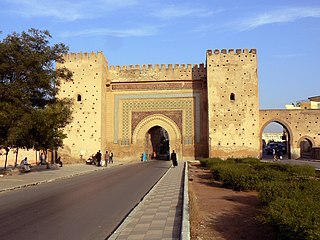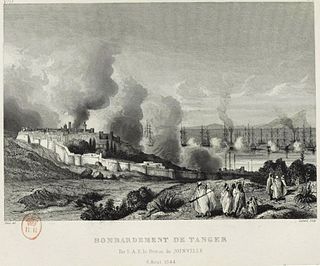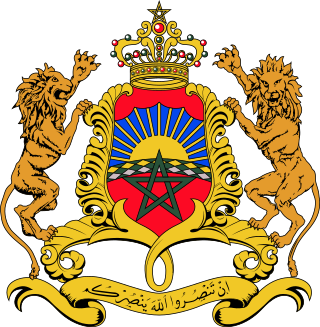Background
Since the start of their occupation of Tangier in 1661, the English had erected a number of forts around the town to help protect it. By the early 1670s, the English garrison in Tangier was relatively at peace but the supply of food was a concern. The new Alawi sultan, Moulay Isma'il, was initially preoccupied with consolidating his power. Large parts of northern Morocco were controlled by Khadir Ghaïlan (or al-Khadr Ghaylan) a warlord who had previously harassed the English and defeated them in 1664.
In 1666, Ghaïlan's priorities were different and, in return for a supply of gunpowder, he allowed the Tangier garrison to occupy a large strip of land around the city to meet their food needs, on the condition that they did not fortify it. The English subsequently violated these terms by building additional forts to expand the colony's size. By the late 1670s, a total of 15 forts had been built by the English beyond the city walls of Tangier.
Khadir Ghaïlan was defeated and killed by Moulay Isma'il's forces in 1673. Moulay Isma'il soon consolidated his power over the country, and by now, his forces had more significant military experience and training than Ghaïlan's warriors. He ordered that the forts outside Tangier be destroyed to reduce the colony back to its former size. The sultan's army attacked the forts intermittently in 1678 and 1679. Differing accounts of the time claimed that the Moroccan army mustered against the city numbered either 15,000 or 7000 men, outnumbering, in any case, the English garrison.
Siege
A determined siege began on 25 March and lasted until 27 October 1680. The English garrison was at first under the command of the Earl of Inchiquin, but in June he was replaced by Palmes Fairborne, who was killed in action on October 24. Moroccan forces were commanded by Qāʾid Omar ben Haddū.
The Moroccans focused first on isolating and destroying the outer forts protecting the city, digging long trenches between them in order to cut off communications. Fighting was interrupted by a truce from 19 May to 15 September. By this point, most of the forts outside the city had fallen and the terms of the truce prevented the English commanders from attempting any refortification. After replacing Inchiquin, Fairborne wrote frequently to London requesting reinforcements. Major reinforcements were eventually sent to defend the city, including 180 cavalry, 200 Scottish infantry, 600 Irish soldiers, 500 seamen, and another unity of 200 Spanish cavalry. This brought the English forces to a total of over 3000 men.
Hostilities were renewed in September, and skirmishes occurred continuously. The last clash took place on October 27, when the English forces were able to drive out the Moroccan forces and fill in the trenches they had dug. According to the English government, the garrison had suffered a total of 564 casualties, while Moroccan casualties were estimated at about 500.

Moulay Ismail Ibn Sharif, born around 1645 in Sijilmassa and died on 22 March 1727 at Meknes, was a Sultan of Morocco from 1672 to 1727, as the second ruler of the 'Alawi dynasty. He was the seventh son of Moulay Sharif and was governor of the province of Fez and the north of Morocco from 1667 until the death of his half-brother, Sultan Moulay Rashid in 1672. He was proclaimed sultan at Fez, but spent several years in conflict with his nephew Moulay Ahmed ben Mehrez, who also claimed the throne, until the latter's death in 1687. Moulay Ismail's 55-year reign is the longest of any sultan of Morocco. During his lifetime, Isma’il amassed a harem of over 500 women with more than 800 confirmed biological children, making him one of the most prodigious fathers in recorded history.

Tangier or Tangiers is a city in northwestern Morocco, on the coasts of the Mediterranean Sea and the Atlantic Ocean. The city is the capital of the Tanger-Tetouan-Al Hoceima region, as well as the Tangier-Assilah Prefecture of Morocco.

Meknes is one of the four Imperial cities of Morocco, located in northern central Morocco and the sixth largest city by population in the kingdom. Founded in the 11th century by the Almoravids as a military settlement, Meknes became the capital of Morocco during the reign of Sultan Ismail Ibn Sharif (1672–1727), son of the founder of the Alaouite dynasty. Sultan Ismail created a massive imperial palace complex and endowed the city with extensive fortifications and monumental gates. The city recorded a population of 632,079 in the 2014 Moroccan census. It is the seat of Meknès Prefecture and an important economic hub in the region of Fès-Meknès.

English Tangier was the period in Moroccan history in which the city of Tangier was occupied by England as part of its colonial empire from 1661 to 1684. Tangier had been under Portuguese control before Charles II of England acquired the city as part of the dowry when he married the Portuguese infanta Catherine. The marriage treaty was an extensive renewal of the Anglo-Portuguese Alliance. It was opposed by Spain, then at war with Portugal, but clandestinely supported by France.

MoulayAbd al-Rahman bin Hisham, born on 19 February 1778 in Fes and died on 28 August 1859 in Meknes, was a sultan of Morocco from 30 November 1822 to 28 August 1859, as a ruler of the 'Alawi dynasty. He was a son of Moulay Hisham. He was proclaimed sultan in Fes after the death of Moulay Sulayman.
Sidi Mohammed ben Abdallahal-Khatib, known as Mohammed III, born in 1710 in Fes and died on 9 April 1790 in Meknes, was the Sultan of Morocco from 1757 to 1790 as a member of the 'Alawi dynasty. He was the governor of Marrakesh around 1750. He was also briefly sultan in 1748. He rebuilt many cities after the earthquake of 1755, including Mogador, Casablanca, and Rabat, and Abdallah Laroui described him as "the architect of modern Morocco." He also defeated the French in the Larache expedition in 1765 and expelled the Portuguese from Mazagan (al-Jadīda) in 1769. He is notable for having been the leader of one of the first nations to recognize American independence in his alliance with Luis de Unzaga 'le Conciliateur' through correspondence and Unzaga's secret intelligence service and led by his brothers-in-law Antonio and Matías de Gálvez from the Canary Islands. He was the son of Mawlay Abdallah bin Ismail and his wife a lady of the Chéraga guich tribe.

The Black Guard or ‘Abid al-Bukhari were the corps of black-African slaves and Haratin slave-soldiers assembled by the 'Alawi sultan of Morocco, Isma‘il ibn Sharif. They were called the "Slaves of Bukhari" because Sultan Isma‘il emphasized the importance of the teachings of the famous imam Muhammad al-Bukhari, going so far as to give the leaders of the army copies of his book. This military corps, which was loyal only to the sultan, was one of the pillars of Isma'il's power as he sought to establish a more stable and more absolute authority over Morocco.

The Franco-Moroccan War was fought between the Kingdom of France and the Sultanate of Morocco from 6 August to 10 September 1844. The principal cause of war was the retreat of Algerian resistance leader Abd al-Kader into Morocco following French victories over many of his tribal supporters during the French conquest of Algeria and the refusal of the Sultan of Morocco Moulay Abd al-Rahman to abandon the cause of Abd al-Kader against colonial occupation.

Moroccan nationality law is regulated by the Constitution of Morocco, as amended; the Moroccan Nationality Code, and its revisions; the Mudawana (Family Code; the Civil Liberties Code; and various international agreements to which the country is a signatory. These laws determine who is, or is eligible to be, a national of Morocco. The legal means to acquire nationality, formal legal membership in a nation, differ from the domestic relationship of rights and obligations between a national and the nation, known as citizenship. Nationality describes the relationship of an individual to the state under international law, whereas citizenship is the domestic relationship of an individual within the nation. Moroccan nationality is typically obtained under the jus sanguinis, i.e. by birth in Morocco or abroad to parents with Moroccan nationality. It can be granted to persons with an affiliation to the country, or to a permanent resident who has lived in the country for a given period of time through naturalization.

Colonel William O'Brien, 7th Baron & 2nd Earl of Inchiquin, PC, was an Irish military officer, peer and colonial administrator who served as the governor of Tangier from 1675 to 1680 and the governor of Jamaica from 1690 until his death in office in 1692. O'Brien is best known for his long career in the service of the English Crown, serving as a colonial governor in England's overseas possessions in Africa and the West Indies.

The French conquest of Morocco began with the French Republic occupying the city of Oujda in 29 March 1907. The French launched campaigns against the Sultanate of Morocco which culminated in the signing of the Treaty of Fes and establishment of the French Protectorate in Morocco on 30 March 1912. France later concluded, on the 27th November, the Treaty of Madrid with the Kingdom of Spain which established the Spanish protectorate in Morocco. The French still conducted a series of military operations to pacify rebellions in Morocco until 1934.
Abu Zakariya Yahya ibn Ziyan al-Wattasi (abū zakarīyā' yaḥyā ben ziyān al-waṭṭāsī Arabic: أبو زكرياء يحيى بن زيان الوطاس was a vizier of the Marinid sultan of Fez, regent and effective strongman ruler of Morocco from 1420 until 1448. He is the founder of the Wattasid dynasty of viziers and later sultans, and as such often designated as Yahya I in Wattasid lists. He was also known by his nickname Lazeraque, as found in Portuguese chronicles.
Sir Palmes Fairborne was an English soldier and Governor of Tangier.

The Tangier Garrison was the land force which oversaw the defence of English Tangier between 1661 and 1684 when it was evacuated. It was part of the English Army, the de facto standing army that Charles II established following the Restoration. Charles II received Tangier as part of the Marriage Treaty with Portugal in 1661. He appointed Henry Mordaunt, 2nd Earl of Peterborough as governor and, on 30 January 1662, the new garrison took up its duties. Peterborough was not a successful appointment as governor, and Andrew, Lord Rutherford, was appointed in 1662/1663 to replace him.
The following is a timeline of the history of the city of Tangier, Morocco.
Sir John Fitzgerald was an Irish soldier of the seventeenth century, best known for serving as Governor of Tangier during the 1660s. He commanded the Tangier Garrison during this time. He later participated in the Williamite War in Ireland (1689–91) on the Jacobite side.
Khadir Ghaïlan was a powerful warlord in Morocco during the seventeenth century. He controlled large swathes of the region until his death in September 1672 at the hands of Moulay Ismail. During the 1660s, He was noted for his clashes with the Anglo-Irish garrison at Tangier. Despite gaining a success over the garrison at the Battle of Tangier (1664) he was never able to seriously threaten the port. He agreed a number of truces with the Governors of Tangier.

The Battle of Tangier, also known as the Battle of Jew's Hill, took place between a detachment of the English Tangier Garrison under the command of governor of Tangier Lord Teviot by a Moroccan force commanded by Khadir Ghaïlan on 4 May 1664. Successfully ambushing the 500-strong English force, Ghaïlan's men killed all but thirty of them, including Teviot. The battle was the bloodiest defeat suffered by the Tangier Garrison during the English occupation of Tangier.
The Battle of Tangier in 1662 was the first major engagement between the Moroccans, led by Khadir Ghaïlan, and the English garrison, led by Nathaniel Fines. The Moroccans routed the English force.
The Battle of Tangier in 1675 was an engagement between the Moroccans and the English garrison of Tangier, who raided the vicinity for cattle. The English raid ended in a fiasco.










